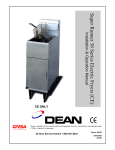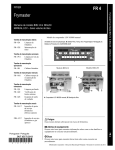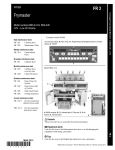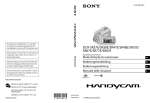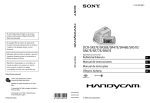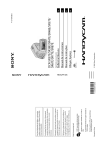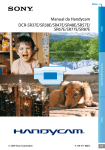Download Dean Cool Zone Series Specifications
Transcript
Cool Zone Series Electric Fryers (CE) Installation, Operation & Maintenance Manual CE ONLY Dean, a member of the Commercial Food Equipment Service Association, recommends using CFESA Certified Technicians. 24-Hour Service Hotline 1-800-551-8633 Price: $6.00 819-5729 11-99 PLEASE READ ALL SECTIONS OF THIS MANUAL AND RETAIN FOR FUTURE REFERENCE. THIS PRODUCT HAS BEEN CERTIFIED AS COMMERCIAL COOKING EQUIPMENT AND MUST BE INSTALLED BY PROFESSIONAL PERSONNEL AS SPECIFIED. WE SUGGEST INSTALLATION, MAINTENANCE AND REPAIRS SHOULD BE PERFORMED BY YOUR LOCAL DEAN FACTORY AUTHORIZED SERVICE AGENCY. WARNING! IMPROPER INSTALLATION, ADJUSTMENT, ALTERATION, SERVICE OR MAINTENANCE CAN CAUSE PROPERTY DAMAGE, INJURY, OR DEATH. READ THE INSTALLATION, OPERATING, AND MAINTENANCE INSTRUCTIONS THOROUGHLY BEFORE INSTALLING OR SERVICING THIS EQUIPMENT. IMPORTANT SAFE AND SATISFACTORY OPERATION OF YOUR EQUIPMENT DEPENDS ON ITS PROPER INSTALLATION. INSTALLATION MUST BE PLANNED IN ACCORDANCE WITH ALL APPLICABLE STATE AND LOCAL CODES OR IN THE ABSENCE OF LOCAL CODES, WITH THE NATIONAL ELECTRICAL CODE, NFPA 70-1984 (OR LATEST EDITIONS). WARNING! DO NOT INSTALL SWIVEL CASTERS ON SINGLE FRYER UNITS. THE UNIT MAY TIP AND CAUSE SEVERE INJURY. LEGS OR A COMBINATION OF REAR FIXED CASTERS AND FRONT LEGS MAY BE INSTALLED ON SINGLE UNITS ONLY. FOR YOUR SAFETY DO NOT STORE OR USE GASOLINE OR OTHER FLAMMABLE VAPORS AND LIQUIDS IN THE VICINITY OF THIS OR ANY OTHER COOKING APPLIANCE. IMPORTANT THE SERVICER/INSTALLER MUST USE A GOOSE NECK AND RETAINER TO PROTECT THE POWER CORD SET. COVER PHOTO Model shown is a multiple fryer battery consisting of 1414E and 714E units with optional casters. DEAN COOL ZONE ELECTRIC FRYERS (CE) INSTALLATION, OPERATION, & MAINTENANCE MANUAL TABLE OF CONTENTS 1 2 3 4 5 6 7 8 PARTS ORDERING/SERVICE INFORMATION IMPORTANT INFORMATION INSTALLATION DAILY OPERATION CLEANING AND MAINTENANCE OPERATOR TROUBLESHOOTING WIRING DIAGRAM PARTS LIST PAGE 2 3 5 10 12 14 15 16 1. PARTS ORDERING AND SERVICE INFORMATION 1.1 ORDERING PARTS: To assist you more efficiently, the following information will be needed: Customers may order parts directly from their local Authorized Parts Distributor. For this address and phone number, contact your Maintenance & Repair Center or call the Dean Factory Service Hotline. The factory address and phone numbers are on the cover of this booklet. Model Number Serial Number Voltage Nature of the Problem To speed up your order, the following information is required: Any other information which may be helpful in solving your service problem. Model Number Serial Number Type of Voltage Item Part Number Quantity Needed 1.3 AFTER SALES: In order to improve service, have the following chart filled in by the Dean Authorized Servicer who installed this equipment. Authorized Servicer Address 1.2 SERVICE INFORMATION: Call the Dean Factory Service Hotline number on the cover of this booklet for the location of your nearest Maintenance & Repair Center or contact the factory direct. Always give the model and serial numbers of your filter and fryer. Telephone/Fax Model # Serial # Type: Fryer Equipped For: 2 2. IMPORTANT INFORMATION kilowatt (kW) output of the heater elements and electrical requirements. 2.1 DESCRIPTION: The Dean Cool Zone (CE) electric fryers are energy-efficient, electrically heated units, certified by NSF and the Underwriters Laboratory and manufactured to their basic performance and application specifications. The Dean Cool Zone (CE) electric fryers are certified for installation and operation in the European Community (CE). DANGER! THE FRYER MUST BE CONNECTED ONLY TO THE TYPE OF ELECTRICAL SERVICE IDENTIFIED ON THE ATTACHED RATING PLATE. Units are shipped completely assembled with any accessories packed inside the fryer vessel. They are adjusted, tested, and inspected at the factory prior to crating for shipment. Sizes, weights and input rates are listed in this manual. 2.3 PRE-INSTALLATION: a. GENERAL: A licensed electrician should install any commercial electric cooking equipment. 2.2 DESIGN SPECIFICATIONS: b. CLEARANCES: The fryer area must be kept free and clear of all combustibles. This unit is designcertified for the following installations: a. VESSEL CONSTRUCTION: Welded, heavy gauge steel with three heater elements fixed inside the vessel with a protective, chromed wire mesh crumb screen over the elements. A drain is tapped into front right corner of vessel with a front-controlled manual drain valve. 1. Other than household use. 2. Non-combustible floor installation equipped with factory-supplied 15 cm (6 inch) adjustable legs, optional 13 cm (5 inch) rigid rear casters, or optional 13 cm (5 inch) locking swivel casters. b. BODY CONSTRUCTION: An aluminized steel base with stainless steel front and enamel sides. The frame is supported by 15 cm (6 inches) adjustable legs or optional 15 cm (6 inches) rigid rear casters. 3. Combustible construction with a minimum clearance of 15 cm (6 inches) side and 15 cm (6 inches) rear, and equipped with factorysupplied 15 cm (6 inches) adjustable legs or 13 cm (5 inches) casters. c. OPERATING CONTROLS: Unit is shipped standard with a liquid filled bulb thermostat. The temperature control is mounted in the cabinet behind the front door on the bottom left side of the cabinet. CAUTION Local building codes usually prohibit a fryer with its open tank of hot oil from being installed beside an open flame of any type, whether a broiler or the open burner of a range. d. AUTOMATIC SAFETY FEATURE: High temperature detection to shut off electric heater elements should the controlling thermostat fail. e. RATING PLATE: This is attached to the inside front door panel. Information provided includes the 3 c. ♦ Concealed loss or damage: If damage is unnoticed until equipment is unpacked, notify freight company or carrier immediately, and file a concealed damage claim. This should be done within fifteen (15) days of date of delivery. Be sure to retain container for inspection. STANDARDS: All electrical cooking appliances must be electrically connected and grounded in accordance with local codes, or in the absence of local codes, with the latest editions of the European Community (CE) standards. 2.4 AIR SUPPLY & VENTILATION: NOTE: Dean does not assume responsibility for damage or loss incurred in transit. a. The area around the fryer must be kept clear to prevent any obstruction to ventilation air flow as well as for service and maintenance. Never use the interior of the fryer’s cabinet for storage. b. A commercial, heavy-duty fryer should be vented to the outside of the building. c. Filters and drip troughs should be part of any industrial hood, but consult local codes before constructing and installing any hood. 2.5 RECEIVING AND UNPACKING: Check that the container is upright. Unpack the fryer carefully and remove all accessories from the carton. Do not discard or misplace these, as they will be needed. After unpacking, immediately check the equipment for visible signs of shipping damage. If such damage has occurred, contact the carrier and file the appropriate freight claims. Do not contact the factory, as the responsibility of shipping damage is between the carrier and the dealer or enduser. If your equipment arrives damaged: ♦ File claim for damages immediately, regardless of extent of damage. ♦ Visible loss or damage: Be sure this is noted on the freight bill or express receipt and is signed by the person making the delivery. 4 3. INSTALLATION 3. If the optional rigid casters are to be installed on single fryers, the casters must be installed on the fryer rear channel assembly only. 3.1 POSITIONING: a. Initial Installation: If installed with legs, do not push against any unit edges to adjust its position. Use a pallet or lift jack to lift it slightly and place it where it is to be installed. 4. Proceed to Step 3.3, Leveling, after legs and/or optional rear rigid casters are installed to ensure the fryer is level before using. b. Relocating The Fryer: If relocating a fryer installed with legs, remove all weight from each leg before moving. Note: b. Leg Installation: 1. Remove unit from pallet. If a leg becomes damaged during movement, contact your service agent for immediate repair/replacement of that leg. 2. Carefully raise unit with forklift, pallet jack, or other steady means. 3. Place one lock washer on each hex head screw. 4. Insert hex head screws with lockwashers (1/4-20 threads by 19mm (¾") long) through bolt holes of leg mounting plates as shown in the Figure 3-1 on the next page. A locknut has been attached to the topside of the mounting plate at the factory to capture the hex head screw as it is screwed in. DANGER! THIS FRYER MAY TIP AND CAUSE PERSONAL INJURY IF NOT SECURED CORRECTLY IN A STATIONARY POSITION. REMOVE ALL SHORTENING BEFORE MOVING FRYER AS IT MAY CAUSE SEVERE BURNS UPON CONTACT. 5. Tighten the bolts and nuts to 5.65 joules (50 inch-lbs.) minimum torque. CAUTION 3.2 LEG AND CASTER INSTALLATION: For leg and caster installations, the unit must be at room temperature and drained of shortening before installing the legs and/or casters. a. General: 1. 2. Install legs and optional rear rigid casters near where the fryer is to be used, as neither are secure for long transit. Unit cannot be curb mounted and must be equipped with the legs (or legs and optional rigid casters) provided. c. Installing Optional Rear Rigid Casters: 1. Install rear rigid casters only at the rear of the single fryer as shown in the Figure 3-1. Legs must be installed at the front of the fryer. When positioning the fryer, gently lower the fryer into position to prevent undue strain to the legs and internal mounting hardware. Use a pallet or lift jack to lift and position the fryer if possible. Tilting the fryer may damage the legs. 2. Follow the same instructions for leg installations as given above in steps 3.2.b.1-5. 5 Structural Back Side Panel Front Channel Rear Channel Side Panel 1/4-20 HX HD Lock Nut Front Door 1/4-20 HX HD Lock Nut Caster Shims if required. Caster Shims if required. Front Channel Front Leg w/Mounting Plate Adjust as needed. Lock Washer Lock Washer 1/4-20 HX HD Screw 1/4-20 HX HD Screw Rear Rigid Caster 13 cm/5 in Locking Caster 13 cm/5 in Leg and Caster Installations Figure 3-1 d. Installing Optional Swivel Casters: 3.3 LEVELING: 1. Swivel casters can only be used with multiple fryer batteries (two or more fryers battered together). a. Place a carpenter’s spirit level across the top of the fryer and level the unit both front-to-back and side-to-side. If the fryer is not level, the unit may not function efficiently, the oil may not drain properly for filtering and in a line-up it may not match adjacent units. 2. Install non-locking casters only at the rear of the unit as shown in the Figure 3-1. 3. Locking casters must be installed at the front of the unit. This allows the fryer to be "locked" in position for safe operations. b. Legs (Only): 1. If the floor is smooth and level, level the unit by using the caster shims. Adjust to the high corner and measure with the spirit level. 4. Follow the same instructions for leg installations as given above in steps 3.2.b.1-5. 2. Adjust leg height with an adjustable or 27mm (1-1/16”) open-end wrench by turning the hex bullet on the bottom of the leg. See figure 3-2 on page 7. WARNING! A FRYER MUST BE LEVEL BEFORE FILLING WITH OIL. IF THE FRYER IS NOT LEVEL, THE FRYER MAY TIP OVER AND MAY CAUSE INJURY TO THE OPERATOR. 3. The hex bullet is for minor leg height adjustment only. Do not adjust more than 22mm (1"). 6 4. When leveling the unit, the leg body should be held firmly to keep the leg from rotating while turning the hex bullet foot to the required height. must be installed on the front channel. 2. Do not use more than two metal shims per caster. 3. There are no thread adjustments for the rigid casters. d. Swivel Casters (Only): 1. Multiple fryer batteries (only): If optional swivel casters are used, the locking swivel casters must be installed on the fryer front channel. Lock casters prior to operating the fryer. 2. Install non-locking swivel casters on the fryer rear channel only. Adjust leg height with an adjustable wrench. 3. Do not use more than two metal shims per caster. Figure 3-2 4. There are no thread adjustments for the swivel casters. WARNINGS! e. If the floor is uneven or has a decided slope, it is recommended to place the fryer on a smooth platform. Do not rely on leg thread or caster shims for adjustments. DO NOT USE MORE THAN TWO METAL SHIMS PER LEG/CASTER. USING MORE THAN TWO SHIMS PER LEG/CASTER MAY CAUSE THE FRYER TO BECOME UNSTABLE, TIP OVER, AND MAY CAUSE INJURY TO THE OPERATOR. f. If the fryer is moved, re-level the fryer following the instructions given in Steps 3.3.a-c. g. This fryer must be restrained to prevent tipping when installed in order to avoid the splashing of hot liquid. The means of restraint may depend on the type of application, such as connecting to a battery of appliances or installing the fryer in an alcove, or by separate means, such as restraining devices. A bracket has been provided on the fryer back panel for this purpose. IF OPTIONAL SWIVEL CASTERS ARE USED ON A MULTIPLE FRYER BATTERY, LOCKING CASTERS MUST BE INSTALLED ON THE FRYERS' FRONT CHANNEL. FAILURE TO LOCK CASTERS PRIOR TO OPERATING THE FRYERS MAY CAUSE THE FRYERS TO MOVE AND CAUSE INJURY TO THE OPERATOR. The install must be reviewed at the time of installation to ensure it meets the intent of these instructions. The on-site supervisor and/or operator(s) should be made aware that there is a c. Rigid Casters (Only): 1. Install the optional rigid casters on the fryer rear channel only. Legs 7 crumb screen. Make sure the screws holding the thermostat and hi-limit control sensing bulbs are tight. restraint on the appliance and, if disconnection of the restraint is necessary, to reconnect this restraint after the appliance has been returned to its originally installed position. b. HEATING THE VESSEL: This step checks heater element operation, initial thermostat calibration, and cleans the vessel for initial food production. CAUTION 1. Fill the fryer vessel with hot or cold water to the oil level line scribed in the back of the tank. The fryer MUST be connected to the voltage and phase as specified on the rating and serial number plate located on the back of the fryer door. 2. Set the thermostat/temperature controller dial to 104°C/220°F, just above that of boiling water. A ground wire MUST be connected to the ground terminal provided near the input power terminal block. 3. Toggle the power switch “ON”. The heater elements will begin heating. 3.4 ELECTRICAL CONNECTIONS: Plan and carry out installation accordance with local codes. in 4. When the water starts to boil, turn the dial to below 99°C/210°F. The elements will turn off and the water will stop boiling. a. Connections: Connections to the terminal block and grounding lug should be made through the hole provided for this purpose in the junction box. To install this fryer, the servicer/installer must use a goose neck and retainer to protect the cord set. 5. When satisfied that the heaters and thermostat operate properly, drain the vessel of water and dry thoroughly. Refill fry vessel with shortening as directed in section 3.6, Final Preparation. b. Wiring Diagram: It is attached to the inside of the fryer door. Amperage for each unit depends on the type of installation and accessories supplied with the unit. A 230/400V Wiring Diagram is provided in Chapter 7. 3.5 INITIAL START-UP: a. CLEANING: New units are wiped clean with solvents at the factory to remove any visible signs of dirt, oil, grease, etc. remaining from the manufacturing process, then coated lightly with oil. Wash thoroughly with hot, soapy water to remove any film residue and dust or debris before food preparation, then rinse out and wipe dry. Wash also any accessories shipped with the unit. Close the drain valve completely and remove the Power Switch 8 Temperature Controller Figure 3-3 3.6 FINAL PREPARATION: a. When using liquid shortening (cooking oil), fill the fryer to the “oil level” line scribed into the back of the fryer vessel. WARNINGS! b. When using solid shortening, either melt it first, or cut into small pieces and pack into cool zone (bottom) of the frying vessel. Do not leave any air spaces or disturb the sensing bulbs. Melt shortening by turning the heaters “ON” for five or ten seconds, “OFF” for a minute, repeating cycle until shortening is melted. If oil starts to smoke while melting this way, shorten the “ON” cycle and lengthen the “OFF” cycle. Smoke indicates oil scorching, shortening its useful life. NEVER OPERATE FRYER WITHOUT ENOUGH COOKING COMPOUND OR WATER IN THE VESSEL TO COVER THE HEATING ELEMENTS. ALWAYS WEAR OIL-PROOF, INSULATED GLOVES WHEN WORKING WITH THE FRYER FILLED WITH HOT OIL. ALWAYS DRAIN HOT OIL INTO A METAL CONTAINER. HOT OIL CAN MELT PLASTIC BUCKETS AND CRACK GLASS CONTAINERS. NOTE: Never melt a solid block of shortening by setting it in the vessel or on top of the heating elements. This is unsafe, inefficient and dangerous. c. When the fryer vessel is filled and the shortening melted, replace the crumb screen gently over the heater elements to prevent splashing of hot oil. Wear gloves when replacing the crumb screen. d. Before starting operation, turn the temperature controller to the probable working temperature; wait for the temperature to stabilize then check with a high-quality immersion thermometer. 9 4.3 TURN ON PROCEDURES: 4. DAILY OPERATION a. If fryer is empty, pour enough shortening into the vessel to fill the vessel to the "oil level” line scribed on the rear wall. If solid shortening is to be used, melt enough in a separate container to cover the heating elements in the bottom of the vessel, then melt the rest in the vessel by turning power switch off and on. 4.1 OPENING: At opening time, always visually check that the power switch and the thermostat are “OFF”. CAUTION If electrical power service is disrupted for more than a few seconds, turn fryer OFF. This will prevent the fryer from accidentally heating oil when power service is resumed. b. Turn the power switch on; set temperature controller to 177°C (350°F). In less than 30 minutes, the frying compound temperature will stabilize and be ready for production. 4.2 GENERAL USE: a. For consistent quality product, convenience and long-term savings, use a high-quality liquid frying compound. 4.4 FILTERING: a. General: Filtering the shortening assures a better taste to the food, minimizes flavors being transferred from batch to batch, and increases frying compound lifespan. WARNING! IF USING SOLID SHORTENING, NEVER MELT A BLOCK OF SHORTENING BY SETTING IT WHOLE IN THE FRYER VESSEL. THIS IS DANGEROUS AND CAN EASILY CAUSE THE SHORTENING SCORCHING, DAMAGE TO THE ELEMENTS OR POSSIBILY A FIRE. Filter the frying compound at least once daily or more frequently if cooking is heavy. b. Prior to filtering, align the portable filter unit under the drain valve. Attach the drain valve extension to ensure shortening flows into the filter safely. c. If using solid shortening, clear return lines before turning off the filter motor and hang any flexible lines up to drain. As it cools, solid shortening solidifies and clogs lines. b. Although a temperature of 177°C (350°F) is recommended for most cooking operations, set the fryer at the lowest possible temperature which produces a high-quality end product while ensuring maximum life of frying compound. d. For more detailed information concerning filtration, review the operator's manual shipped with your filter unit. c. When the fryer is not in use, the thermostat should be set lower than that used during cooking. 10 CAUTION When filtering, never leave the filter unattended. Always point the flexible oil return hose nozzle down into the fry vessel to prevent spraying of hot oil which may cause severe burns. 4.5 CLOSING: When closing at night, filter oil in all fryers and drain the filter lines. Cover the open tanks of oil. Turn power switch “OFF”. 4.6 SHUTDOWN: When shutting down for periods longer than overnight, drain the frying compound and clean the vessel thoroughly. Either discard the frying compound or return it filtered to the vessel and then cover it. Turn both the power switch and temperature controller “OFF”. 11 5. CLEANING & MAINTENANCE To return the unit to its previous installed position see sections 3.3 and 5.3 of this manual. 5.4 WEEKLY: WARNING a. IF FRYER IS NOT COMPLETELY EMPTY OF OIL, ADJUSTMENT, ALTERATION, SERVICE OR MAINTENANCE CAN CAUSE PROPERTY DAMAGE AND PERSONAL INJURY. Completely drain the oil from the fry vessel into either the filter or a steel container. Do not use a plastic bucket or glass container. b. Clean the vessel with a good grade of cleaner or hot water and a strong detergent. c. 5.1 GENERAL: Any piece of equipment works better and lasts longer when maintained properly and kept clean. Cooking equipment is no exception. The fryer must be kept clean during the working day and thoroughly cleaned at the end of each day. Close the drain valve and refill with either the cleaning solution or water and detergent. d. Set operating thermostat to 104°C (220°F). Bring to a rolling boil, then turn the heat down and let the mixture stand until deposits and/or carbon spots can be rubbed off with the Teflon brush. 5.2 DAILY: Wash all removable parts. Clean all exterior surfaces of the body. Do not use cleansers, steel wool, or any other abrasive material on the stainless steel. Filter the cooking oil and replace if necessary. The oil should be filtered more often than daily under heavy use conditions. e. Scrub tank walls, bottom and heating tubes. Then drain vessel and rinse in clear water. CAUTION Do not drain water into the filter. Water will damage the filter pump. 5.3 ACCESS FOR SERVICING: The appliance is equipped with a bracket attached on the center of the structural back to connect a restraining device supplied by the installer. The restraining device should meet the requirements specified in section 3.3.f of this manual. In addition, if the installed fryers have casters provided by Dean Industries, both rear casters come with a locking mechanism that prevents the fryer from moving when the lever or each mechanism is turned “ON”. f. Refill with clear water, set operating thermostat to 104°C (220°F), and boil again. Once boiling is completed, turn operating thermostat “OFF”, drain, rinse, and dry thoroughly. CAUTION Do not let water boil down to the point that elements are exposed as this will damage them. To gain access for servicing, the restraining device has to be removed from the bracket and both front caster's locking mechanisms have to be turned “OFF”. g. 12 Immediately refill with cooking oil or frying compound as directed in Section 4.3. WARNING DO NOT LET WATER SPLASH INTO THE TANK OF HOT OIL. IT WILL SPLATTER AND CAN CAUSE SEVERE BURNS. 5.5 PERIODIC: The fryer should be checked and adjusted periodically by qualified service personnel as part of a regular kitchen maintenance program. 5.6 STAINLESS STEEL: All stainless steel fryer body parts should be wiped regularly with hot, soapy water during the day and with a liquid cleaner designed for this material at the end of each day. a. Do not use steel wool, abrasive cloths, cleansers or powders! b. Do not use a metal knife, spatula or any other metal tool to scrape stainless steel! Scratches are almost impossible to remove. c. If it is necessary to scrape the stainless steel to remove any encrusted materials, soak the area first to loosen the material, then use a wood or nylon scraper only. 13 6. TROUBLESHOOTING GUIDE The problems and possible solutions given below cover those most commonly encountered by operators. FOR DETAILED TROUBLESHOOTING AND SERVICE-RELATED INFORMATION, CALL THE DEAN SERVICE HOTLINE AT 1-800-551-8633 (USA/Canada only) or 1-318-865-1711. PROBLEM Operator hears click sound when the temperature controller dial is turned but vessel remains cold. No evidence that elements are warming the vessel. CORRECTIVE ACTION With the power switch “ON”: 1. Manually reset the high temperature limit switch (push red button on the panel above the drain valve). See Figure 6-1. 2. Check for tripped branch or main circuit breakers or blown fuses. Check thermostat adjustment: Poor temperature control on the cold side or hot side; excessive warm-up time; temperature recovery is slow or inadequate when vessel is loaded; uneven heating; excessive temperature overshooting during warm-up; scorching; overheating; or high limit switch must be reset often. 1. Check that the thermostat bulb/probe in the vessel has not been knocked loose from its operating position. It should be clamped to the second element with 1,5 mm (1/16 inch) spacing. See Figure 6-2. 2. Place the sensing bulb of a high quality immersion thermometer about 38 mm (1-1/2 inches) above the thermostat sensing bulb and set the temperature controller dial to 177°C (350°F). 3. Wait at least 30 minutes for the oil temperature to stabilize. 4. If temperature is not within +/- 5°C (10°F) of the dial setting, call service for a new operating thermostat/temperature controller. High Limit Reset Switch Drain Valve Sensing Bulb in Fryer Vessel Figure 6-2 Figure 6-1 14 7. WIRING DIAGRAM BRN YEL RED PURP BLK#2 WHT#2 BLU Hi-Limit PURP P/N 2687 Fuse 5 Amp P/N 1693 RED K1 K2 YEL 230/400V = 17.118 KW Total 25.0 Amps P/N 14-0592-6 K1 = Latch Contactor P/N 810-1202 K2 = Heat Contactor P/N 810-1202 Electric Fryer 230/400V 24V Contactors June 1999 Power Switch (SPST) P/N 807-2196 BLU YEL YEL WHT#2 YEL Oper Thermostat P/N 2557 Neutral Leg 3 Leg 2 Leg 1 15 BLK#2 240V Transformer P/N 807-1999 24V BRN Terminal Block P/N 1501-1 4 Wire 3 Phase Ground Terminal Wiring Diagram Cool Zone Electric Fryer (CE) 8. COOL ZONE 1414E ELECTRIC (CE) PARTS LIST ITEM 1 2 3 4 5 6 7 8 PART NUMBER 2698 1942 1943 44-1363 36004-1 36-0014-1 12-0097 1503 1039-2 9002949 12220 12-0309-2 1501 1501-1 DESCRIPTION LEG, BLACK, ADJUSTABLE WITH MOUNTING PLATE, 6" CASTER, 5" W/BRAKE CASTER, 5" W/O BRAKE NIPPLE, DRAIN EXT. 1-1/4” DOOR ASSY DOOR PANEL DOOR PIN MAGNETIC DOOR CATCH HANDLE, CHROME/DOOR SHIM CASTER GRID ASSEMBLY FRONT CNTRL PANEL TERMINAL BLOCK 3 WIRE TERMINAL BLOCK 4 WIRE 16 ITEM 9 10 11 12 PART NUMBER 29 30 31 32 33 24-0350 36-0012 8101202 12-0311 50-0041-1 50-0041-2 2557 1205 2025 8072196 12-0376 12-0323 12210 12-0322 14-0193 2066-1 36-0048 12-0237 2687 12212 14248-2 14-0592-6 1902 14-0695 2189 18-0041 14-0883 18-0041 18-0040 18-0031 12193 18-0031 18-0061 12-0377 34 Not Used 35 36 37 39 40 41 Not Shown Not Used 36-0026-2 2608 8071999 1692 1693 14673 44-1362 13 14 15 16 17 18 19 20 21 22 23 24 25 26 27 28 DESCRIPTION LOWER HINGE BRACKET FRT & REAR CHANNEL 40 AMP 3 POLE CONTACTOR (CE Only) CNTRL PANEL BACK SR38 SIDE PANEL PP/GREY LH SIDE PANEL PP/GREY RH THERMOSTAT, SUNNE #TC125-004 KNOB,THERMOS R/S KXD POWER SWITCH (ROCKER SWITCH, CARLING) POWER SWITCH (GRN LIGHTED ROCKER SWITCH) MOUNTING PLATE CONTCTR, SR38ECE COVER CONTACTOR BOX, SR38E BOX, CONTACTOR WELD ASSY,SR38E (CE) COVER HEATER RACEWAY, SR38E GOOFER ROD DECLOGGER DRAIN VALVE,1-1/4"(1"STD PORT) STRUCTURAL BACK RESTRAINING BRACKET HI LMT 410 DEG F,W/MAN RESET CE BOX RACEWAY/CONTCTR ASSY,SR38E (CE) VESSEL WELD ASSY SS HEAT ELEMENT 208V 4666W O RING SEAL (4 EA ELEMENT) O-RING RETAINER WASHER (4 EA ELEMENT) JAM NUT ¾-16 (2 EA ELEMENT) CLAMP; THERMOSTAT 1 EA USA, 2 EA CE SPRING/ROBERTSHAW/SPACER CLAMP; THERMOSTAT 1 EA USA, 2 EA CE HIGH LIMIT CLAMP USA SPACER HEAT ELEMENT BRACKET ELEMENT SPRT, SR38E SPACER HEAT ELEMENT SUPPORT HEAT ELEMENT COVER, LOWER CNTRL BOX SR38E (CE Only) BASKET HANGER FRY BASKET TRANSFORMER PRIMARY 208/240V (CE Only) FUSE HOLDER W/LEADS FUSE 5 A OPERATIONAL THERMOSTAT WIRING HARNESS BRACKET,DRAIN NIPPLE EXTENSION 17 Dean, 8700 Line Avenue, Shreveport, Louisiana 71135 TEL 1-318-865-1711 PRINTED IN THE UNITED STATES FAX (Parts) 1-318-219-7140 SERVICE HOTLINE 1-800-551-8633 (Tech Support) 1-318-219-7135 Price: $6.00 819-5729 11-99




















